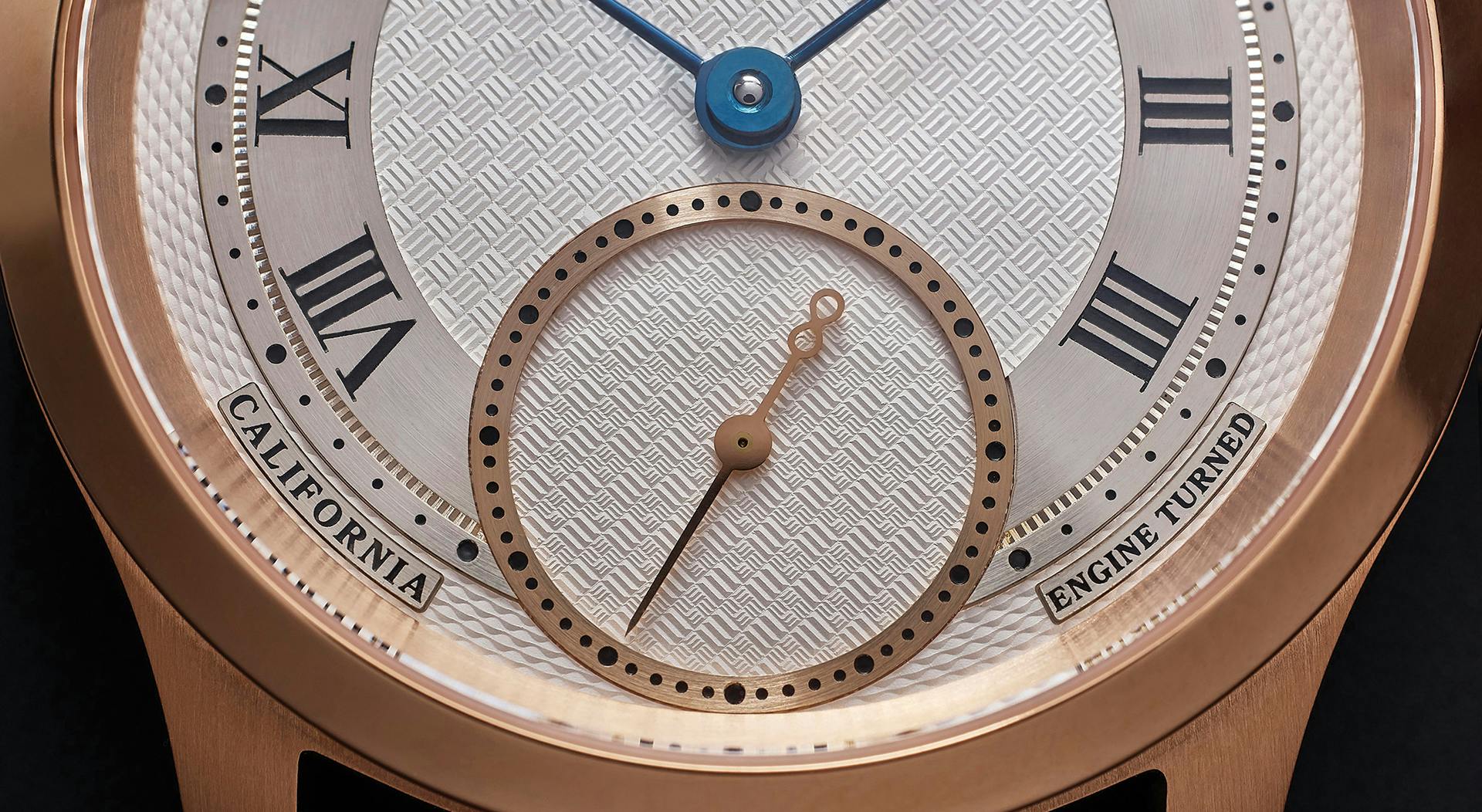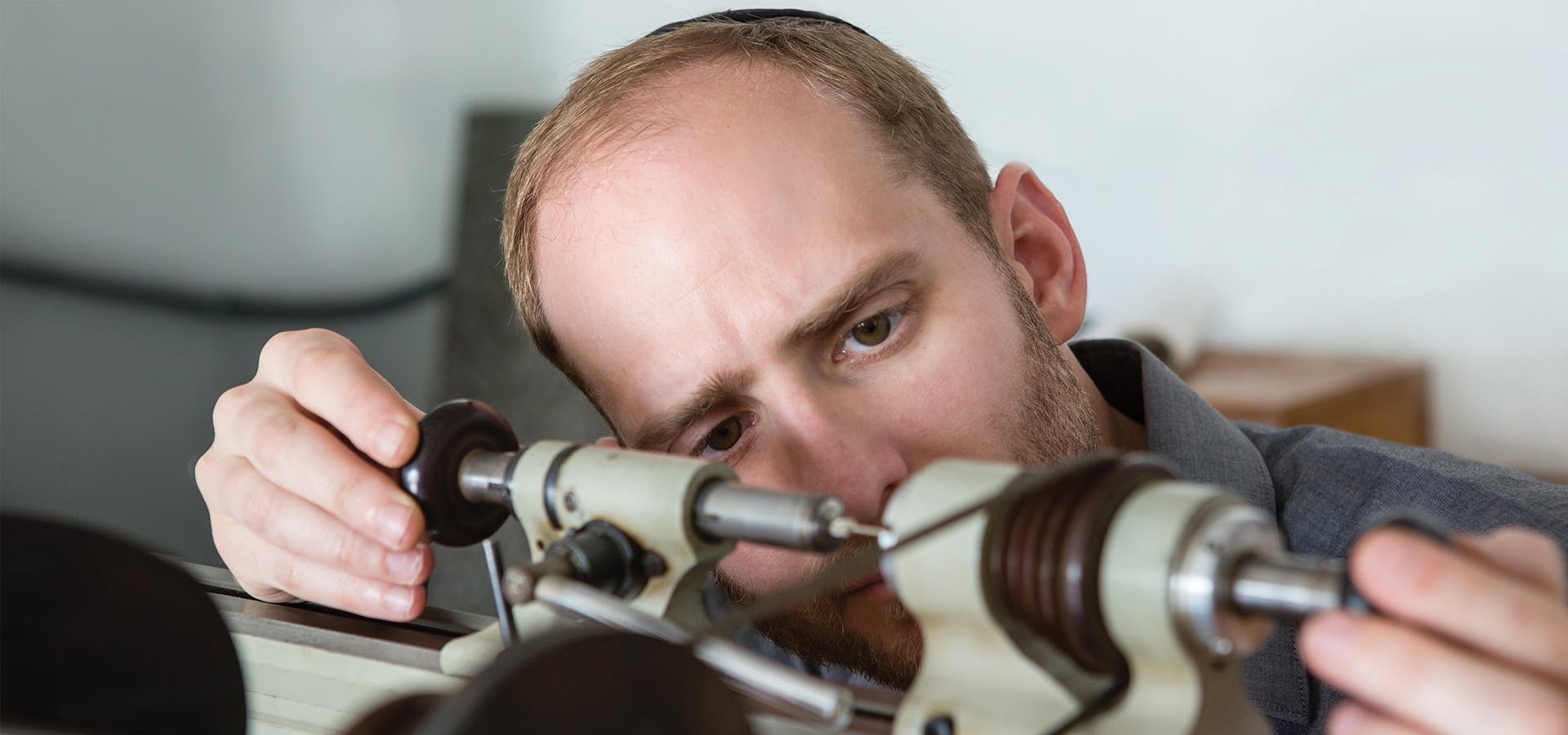Every story has an origin point. Joshua Shapiro’s journey as a watchmaker has two.
In 2011 Josh’s wife gifted him a quartz Bulova wristwatch on their wedding day. In some ways, that watch was the catalyst to his now passionate commitment to building complicated mechanical timepieces of his own.
However, it wasn’t the watch itself that sparked his enthusiasm. It was an advertisement he saw at Feldmar Watch Company when he took his wedding gift to the boutique on Pico Boulevard in Los Angeles to have his watchband resized. The poster that caught Josh’s eye showcased a skeletonized timepiece—a watch that lacks a customary dial and instead shows many of the intricate moving pieces at its core.
“I was pretty enthralled,” the 36-year-old recalls. “I wondered what it takes to make a watch like that—to skeletonize a watch.”
At the time Josh worked as the principal and taught history at a private Jewish high school. Over the next year he spent much of his free time researching and learning about watchmaking, including the intricate processes and the mechanical wizardry the trade required. In the spring of 2012—wanting to formally learn the vocation—he enrolled in a distance learning program offered by the British Horological Institute.
“I don’t think it’s possible to obtain perfection objectively, but the pursuit of that makes us better people. I hope people are inspired by my infinity weave and are inspired to pursue perfection in whatever they’re doing.”
Through that program, Josh was introduced to the late George Daniels’ seminal tome—a 462-page compendium simply titled Watchmaking. Widely regarded as one of the greatest watchmakers of the last 250 years, Daniels published his comprehensive guide to watchmaking in 1981, and its contents have inspired a handful of today’s most exceptional and highly revered independent watchmakers.
“It seemed extremely daunting,” Josh remembers. “When you’re just starting out, the amount of tools you need to make a watch, which tools to buy, which makers to buy them from and then how to use them … there’s a tremendous amount to learn. Daniels doesn’t walk you step-by-step through the very basics of some of these things. You have to figure that out on your own. Invariably, you have to talk to other watchmakers.”
Josh recalls his initial experiences reading Daniels’ book. “He’ll reference a mandrel or a faceplate, and you’ll have no idea what these things are. They’re just words on paper to explain a process, and it’s only by getting your hands dirty and figuring those things out that you can understand it.”

Fortunately, Josh had some experience getting his hands dirty. That’s the second origin point of his watchmaking tale.
For all intents and purposes, he grew up inside a machine shop. His grandfather was, as Josh describes him, “a renaissance man.” He worked with his hands and did a little bit of everything. He was involved in the Manhattan Project during the 1940s, working as a welder. Once he retired, the elder Shapiro refined metals and poured his own gold bars.
“I smelted gold when I was 6 years old,” Josh says, recalling time spent with his grandfather. “That was really cool.”
Josh’s father followed in his father’s footsteps, operating a sandblasting shop in the same work space where the watchmaker’s grandfather had toiled. Reflecting on his childhood years, Josh acknowledges that he got to see a lot of beautiful vintage cars up close, as their owners regularly brought them into the shop to have their fading paint jobs stripped and prepped for a new color application.
“It was a fun childhood,” he says. “The shop itself was a huge junkyard. I spent my childhood climbing over junk and old machines, getting filthy and chasing lizards.”
The appreciation for metals and a desire to work with his hands were both ingrained in Josh during his childhood, and reading Daniels’ book while engaging in the lessons taught through the British Horological Institute pulled them to the forefront of his consciousness. In particular, Watchmaking introduced him to the practice of guilloché—a decorative technique that utilizes engine-turning machines to mechanically engrave an intricate, repetitive pattern onto a metallic surface.
The art of guilloché appealed to the aspiring watchmaker. After an early foray spent skeletonizing as many movements as he could find, Josh focused his attention on this specific technique—knowing that if he were to master it, he could craft exceptional dials that would lead to even bigger projects down the road.
After finishing the self-guided aspect of the British Horological Institute’s study program in 2012, Josh spent the next three years waffling about his future plans as they pertained to the trade. As he acknowledges, “There was a limbo stage.”
He collected modern and vintage timepieces (a hobby he still pursues) while also acquiring the necessary classical machinery he would need to build watch components himself. By the beginning of 2015, Josh owned a set of engine-turning machines. However, not knowing then how seriously he wanted to pursue the trade as a profession, he sold them to actor Aldis Hodge—who serves as a board member of the Horological Society of New York and also enjoys a successful side hustle as a watch designer.
The sale of those machines allowed Josh to acquire a Patek Philippe Calatrava—a classic modern wristwatch from the revered Swiss horological house. But only a month later he knew he had made a mistake, in part because he was then certain that he wanted to transition to watchmaking as his long-term profession. After tracking down another pair of engine-turning machines—a British rose engine from the 1920s and a German straight-line engine from the 1940s—Josh sold the Calatrava, along with a 1967 Ford Mustang Fastback, to raise the necessary funds to purchase them.
“It still hurts me,” he says of the thought of selling that revered muscle car, “but it was definitely the right decision. I bought the other set of machines and never looked back.”
Now, from a 2,800-square-foot shop outfitted with almost $1 million worth of machinery—both vintage and contemporary devices—Josh crafts elegant, complicated wristwatches that start at $26,000 and can cost as much as $40,000. “I can be working on a machine that’s 100 years old that’s all hand-operated with no electricity, and then go to another machine made a few years ago that uses lasers and computers,” he says.

Three years ago, Josh unveiled a selection of introductory timepieces under his eponymous watch brand J.N. Shapiro that comprise the Infinity Series. They feature multilevel, engine-turned dials accented by a signature repeating guilloché pattern that Josh invented—a finishing technique that requires a week to complete and is the first of its kind. “It’s extremely difficult to do, and I still mess it up quite frequently,” Josh says of the pattern that he describes as a basketweave within a basketweave. “It’s classy and timeless, but it’s also mind-boggling.”
Since unveiling the Infinity Series in the summer of 2018, Josh has received more than 60 orders—thus far fulfilling about half of them. Along the way, the burgeoning watchmaker unveiled a limited, 10-piece special edition of the wristwatch that featured an engine-turned dial made of meteorite. But that only scratches the surface of the advancements and new offerings Josh has planned.
As he’s grown more comfortable in the trade—and as he’s proven to himself that he can machine other watch components at a high level—Josh has ventured beyond engine-turned dials. He has begun making cases in-house, which he acknowledges is a difficult undertaking. He will soon unveil a limited-edition watch that is housed in a case made of tantalum—a dense, blueish-gray alloy. According to Josh, that release will mark the first time a wristwatch with a tantalum case has been manufactured outside Switzerland.
Additionally, Josh has plans to introduce a time-only watch powered by an in-house movement. (Up until now, his Infinity Series timepieces have utilized an outsourced Swiss movement made exclusively for the brand.) He also acknowledges that he will eventually unveil a tourbillion and has already accepted an order from an existing customer.

Josh anticipates that the aforementioned time-only wristwatches will likely cost twice as much as the Infinity Series pieces and that the tourbillions will likely carry a price tag more than double the cost of a time-only watch. As for that already-reserved tourbillion prototype, he says it will require thousands of hours of work, all of which will ultimately guide him in setting a commensurate price for future models.
“It doesn’t matter what machinery you have; there’s a lot to figure out and a lot you have to do,” he says. “There’s a lot of trial and error and making parts one at a time.”
Although the events that ultimately led Josh away from a career in education and into watchmaking occurred recently, they aren’t so contemporary that he’s unaware of their significance. “The machines called me back,” he says. “Now I’m all in for watches, and I’m so glad.”
Josh shares the mission statement of his business: the pursuit of perfection. “I don’t think it’s possible to obtain perfection objectively, but the pursuit of that makes us better people. I hope people are inspired by my infinity weave and are inspired to pursue perfection in whatever they’re doing.”
As for his own horological pursuits, Josh is still constantly learning—through both hands-on trial and error, and studious research. On the latter topic, he still routinely opens the tome that drew him so passionately into the craft of watchmaking—and it’s one that he knows still holds future discoveries. “Even now, I don’t understand every part of that book.”










